100 Stories
Getting Around Hiroshima: An Easy Transportation Guide
It can be frustrating to find your way around a new city, but Hiroshima doesn’t have to be! This article can be your guide so you can just relax and enjoy this wonderful city.
What Public Transportation does Hiroshima have to offer?
The three most common modes of public transportation for both locals and tourists are trains, streetcars and buses.
Route Maps:

This map, provided by www.hiroden.co.jp, outlines the city’s streetcar routes (the colorful lines) and the train routs that go through the city (checkered grey and white is JR and orange dot is Astram)
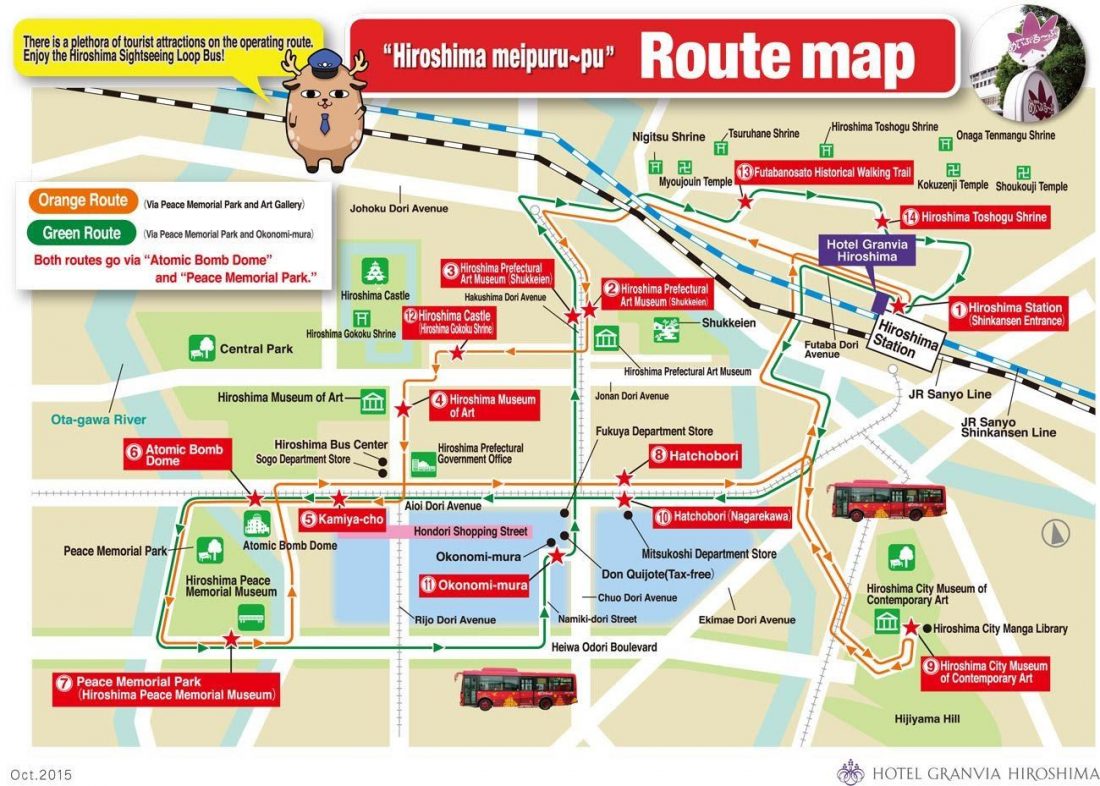
This map, provided by hgh.co.jp, outlines the “Meipuru~pu” bus routes. It does the same loops all day, every day, stopping at many of Hiroshima’s famous sights, passengers can get on and off at any stop. *Note the Meipuru~pu is not the usual city bus, so the fare and stops are different.
How to Pay for Public Transportation:
- Cash (not recommended if you plan to travel around a lot)
- IC cards (ex. ICOCA, Manaca, Suika, Paspy)
- Day passes (not recommended if you plan to be in the city for more than a day or two and plan to use more than one type of transportation BUT recommended if you are short on time) *Note: ask staff at Information Centers ex. in Hiroshima Station or the Bus Center, for more information.
What are IC cards and how to use them?
IC cards are rechargeable cards. ICOCA and Paspy are the local IC cards but you can use other IC cards like Manaca and Suika in Hiroshima as well. ICOCA cards can also be used outside of Hiroshima. 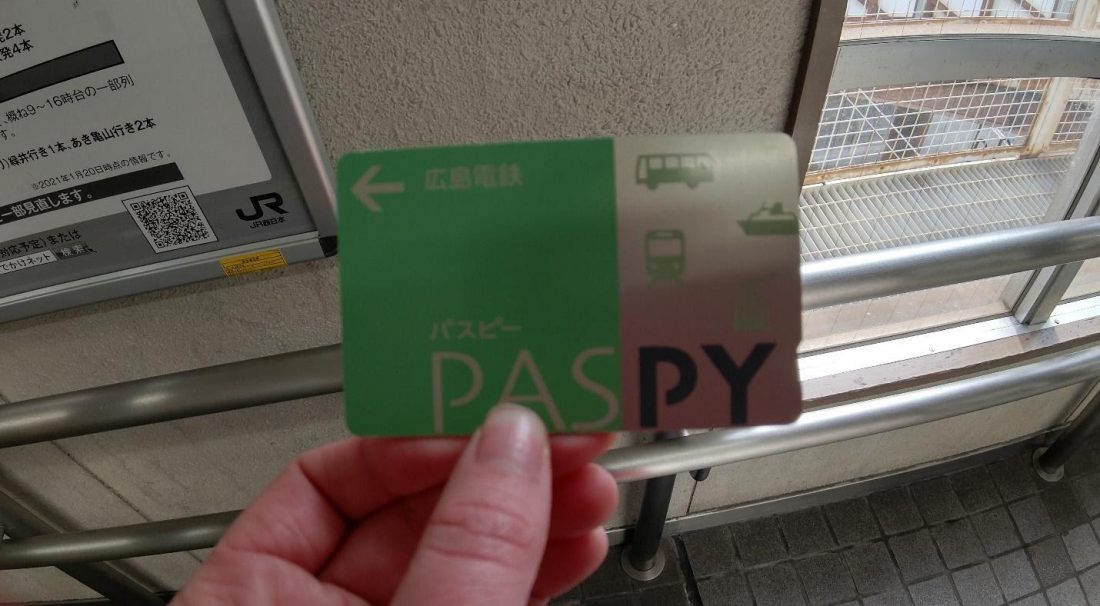
Hiroshima’s “Paspy” IC card. Good for streetcars, buses, the Astram line train and the Hatsukaichi Ferry to Miyajima (Paspy card holders get discounted fares)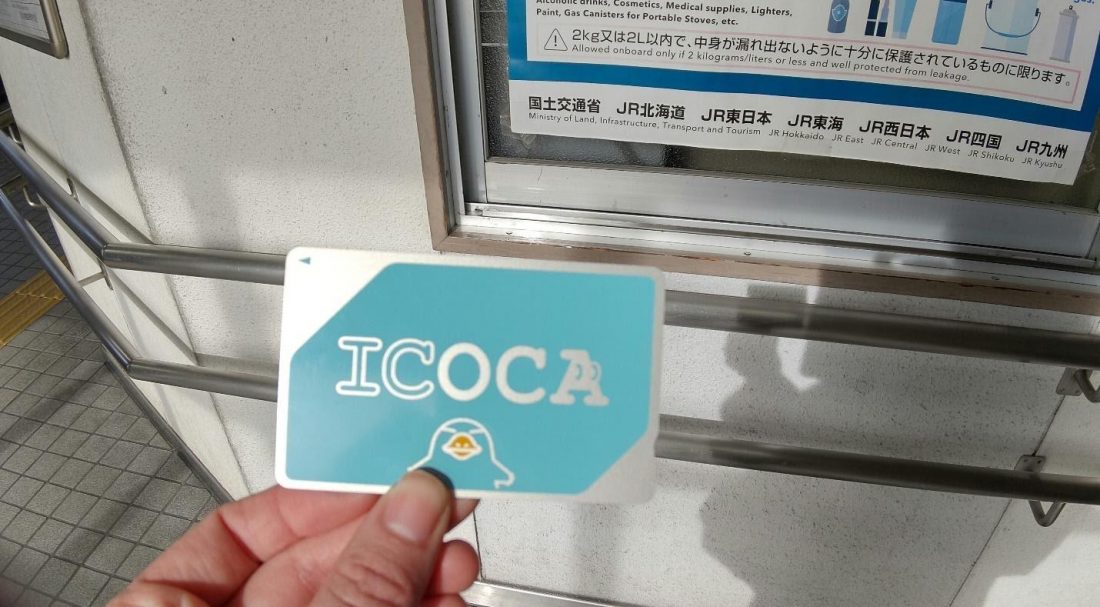
Hiroshima’s “ICOCA” IC card. Good for JR trains, streetcars, buses, rental bicycles and the Hatsukaichi Ferry to Miyajima (can also be used on JR trains throughout most of Japan).
Buying your initial IC card costs ¥500 on top of however much money you want to have on your card. Use the card to travel around the city until the funds run out. Then, you can choose to “recharge” the card by putting more money on it. The point of an IC card is to save yourself the hassle of dealing with cash every time you travel and IC cards are accepted by most modes of transportation in Hiroshima. 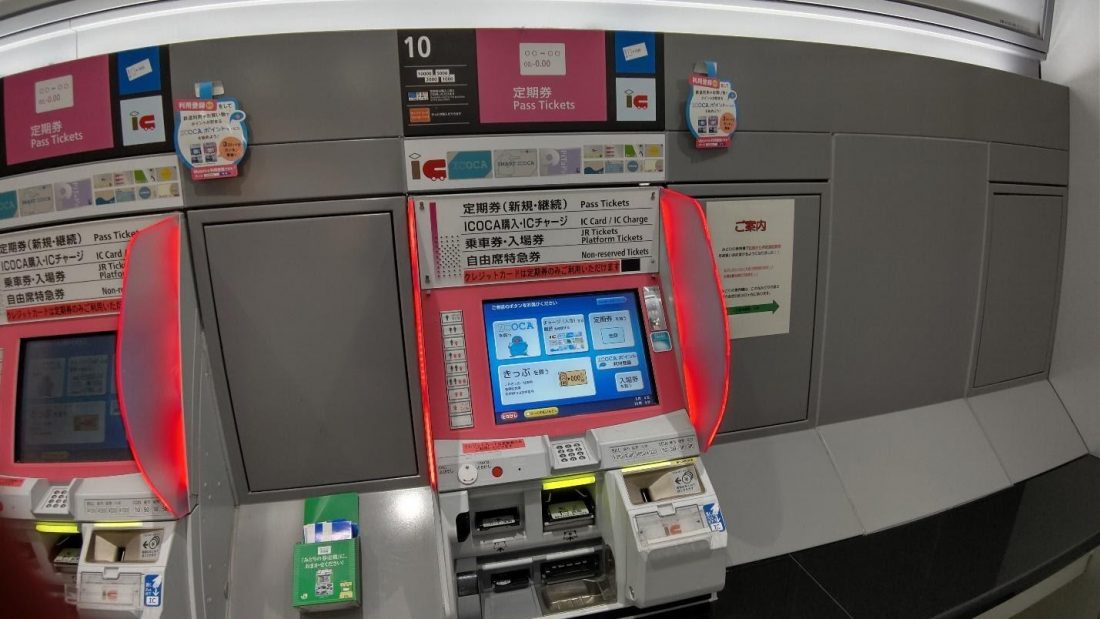
ICOCA cards are available for purchase at this machine, outside the JR ticket gates at Shininokuchi Station. Most major stations have these machines (with English instructions)
Charging machines for ICOCA (Manaca, Suika ect.), are around JR stations, and charging machines for Paspy are around major streetcar and bus stations (and always inside streetcars and buses).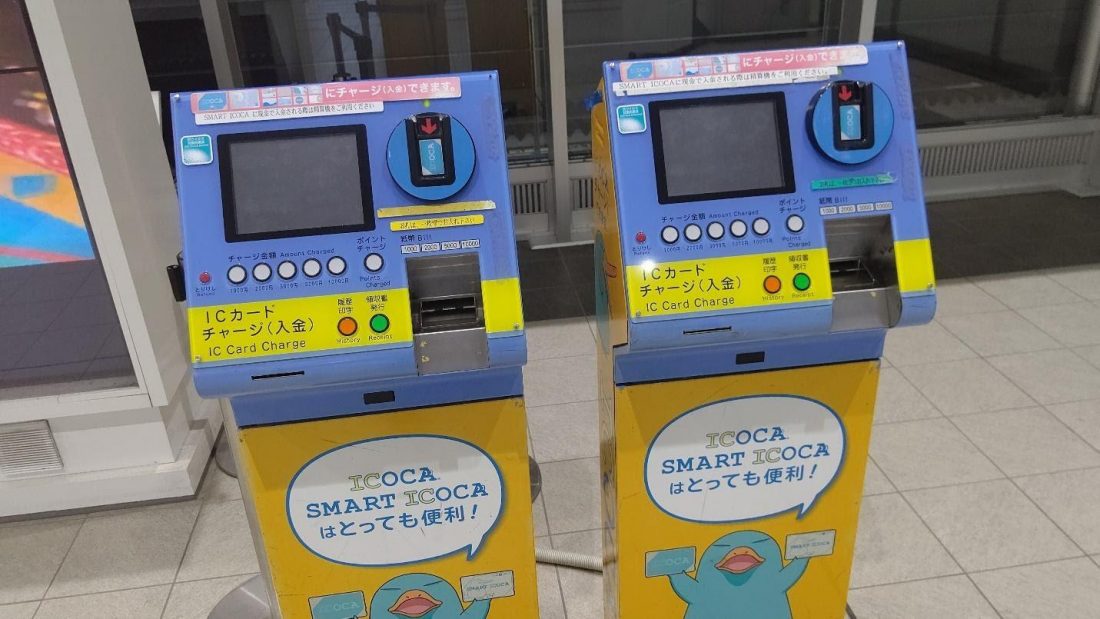
Charging machines for ICOCA by the JR ticket gates at Hiroshima Station (they always have English instructions)
Hiroshima’s Major Stations
There are several major stations in the city that provide different services.
広島駅 “Hiroshima eki” Hiroshima Station: The City’s Largest Station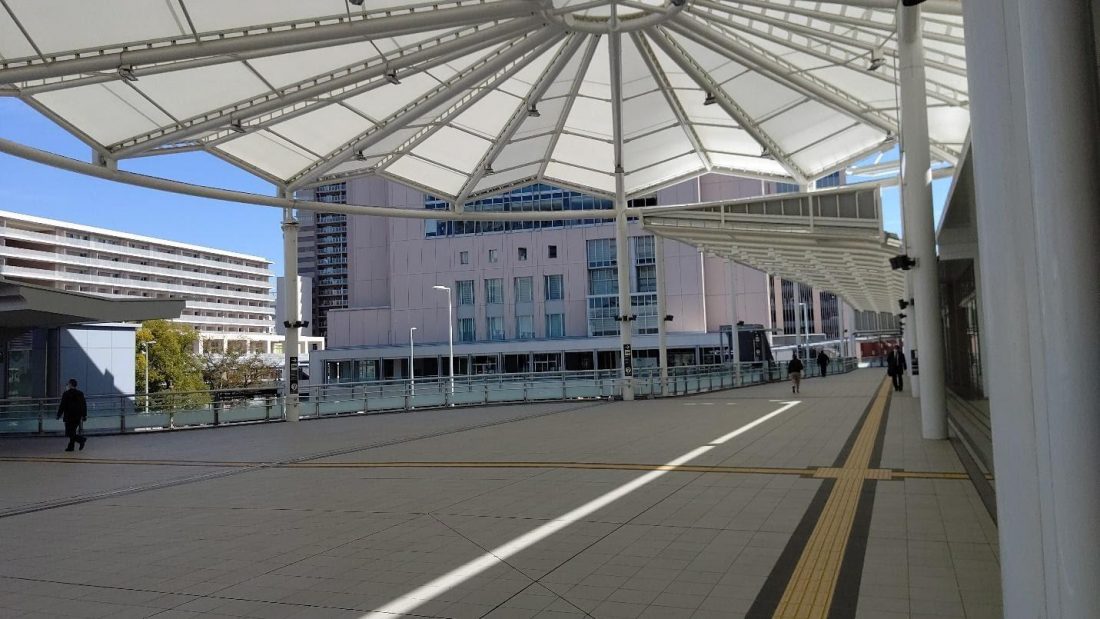
Walking path, second floor, North Entrance of Hiroshima Station
Many of Hiroshima’s visitors first arrive at Hiroshima Station because it has bullet trains, cross-country buses, and Hiroshima Airport buses. You can get almost anywhere in the city from this station because it has JR trains, city buses and streetcars.
Outside the North Entrance of Hiroshima Station there are:
- Cross-country bus terminals
- A Hiroshima Airport bus stop
- A Meipuru~pu bus stop
- Taxi pickups and drop offs
- Public parking
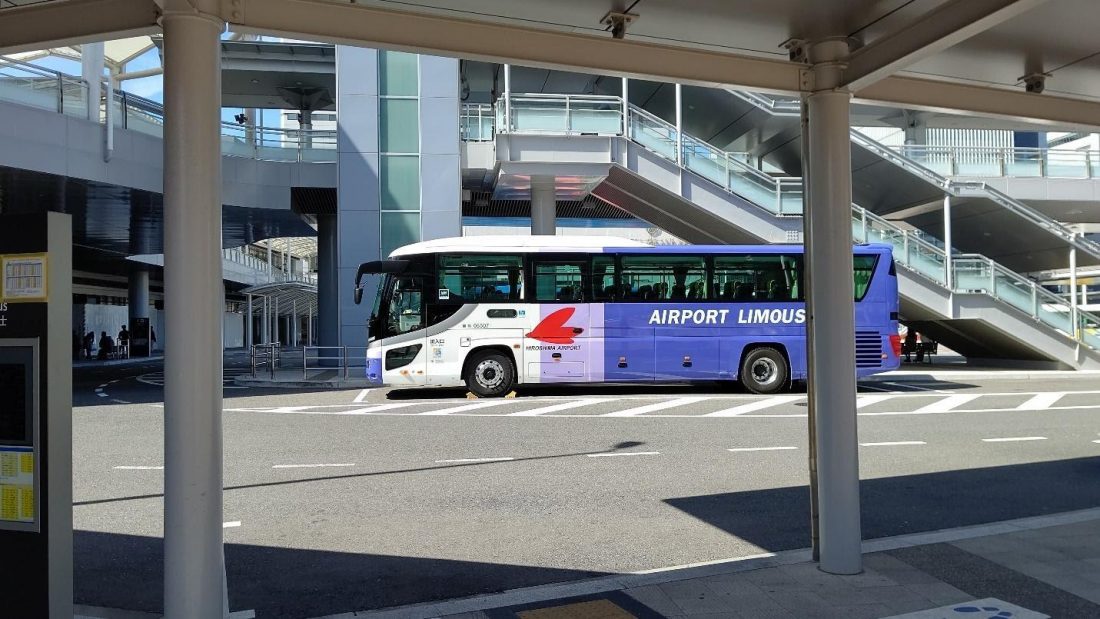
Ground floor bus terminals, outside the North entrance of Hiroshima Station
Outside the South Entrance of Hiroshima Station there are:
- City bus terminals
- Streetcar platforms
-Number 1 to Hiroshima Port (goes west through downtown but NOT as far as the Peace Memorial Park before heading south)
-Number 2 to Miyajima Guchi (goes west through downtown stopping at the north entrance of the Peace Memorial Park before continuing all the way to Miyajima Guchi)
-Number 5 to Hiroshima Port (goes straight south from Hiroshima Station past Hijiyama Park)
-Number 6 to Eba (goes west through downtown stopping at the north entrance of the Peace Memorial Park before going south)
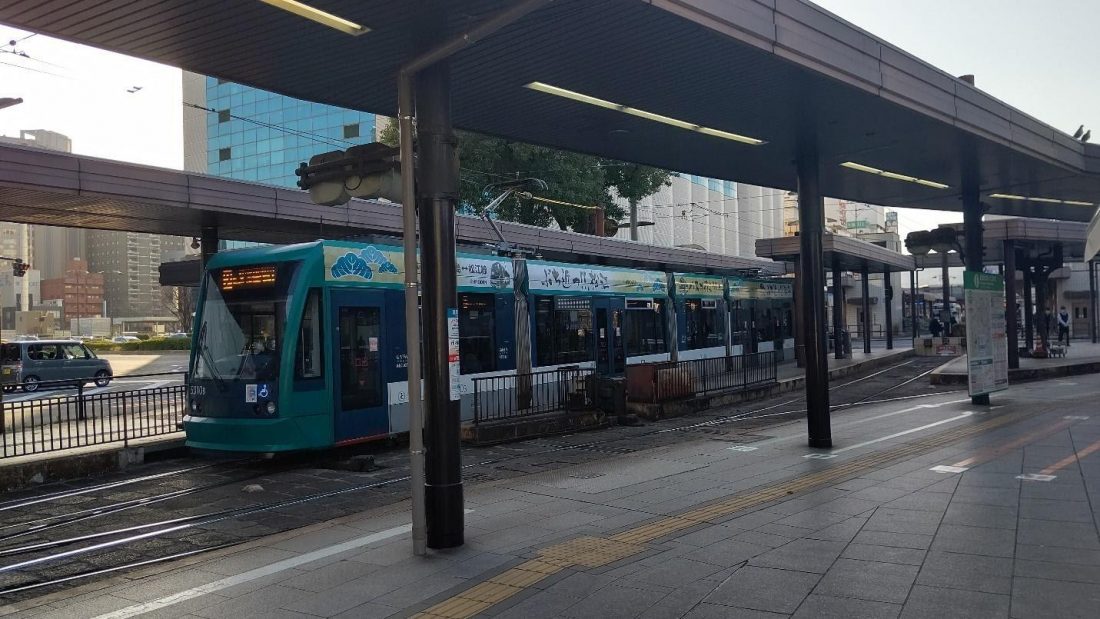
Ground floor streetcar terminals, outside the South entrance of Hiroshima Station
2nd Floor, inside Hiroshima Station
- Information Center for Hiroshima city
- Bullet Train ticket counter and gates
- JR train ticket counter and gates
-Sanyo Line (goes east to west across the city)
-Geibi Line (goes north away from the city)
2nd floor JR ticket gates, inside Hiroshima Station
広島バスセンター “hiroshima basusenta” Hiroshima Bus Center: In the Center of Hiroshima City, Across from the Peace Memorial Park
Hiroshima Bus Center and the SOGO Department Store
The Hiroshima Bus Center is on the 3rd floor of a huge department store called SOGO. This is also a common place for newcomers to arrive in the city because it has cross-country and Hiroshima Airport buses. You can get to a lot of places in the city from the Bus Center because it has city and Meipuru~pu buses.
The Bus Center is a large transportation hub for the city, so they have an information center and ticket counters.
Other Major Stations in the City:
- 新白島駅 “shinhakushima eki” Shinhakushima Station
-JR Sanyo Line (east to west through the city)
-Number 9 streetcar (to Hachobori)
-Astramline (train system, separate from JR, that goes north to south across the city)
-City bus terminals
- 横川駅 “yokogawa eki” Yokogawa Station
-JR Sanyo Line (east to west through the city)
-JR Kabe Line (north away from the city)
-Number 7 streetcar (to Hiroden Honsha Mae)
-Number 8 streetcar (to Eba)
-City bus terminals
- 西広島駅 “nishi Hiroshima eki” Nishi Hiroshima Station
-JR Sanyo Line (east to west through the city)
-Number 3 streetcar (to Hiroshima Port)
-City bus terminals
電車 “densha” Trains

Hiroshima has two types of trains, the Japanese Railway (JR) system and the Astram line system. The JR system is government run and stretches across the whole country while the Astram line system is privately owned and local. Depending on your travel plans, you may prefer one to the other because they don’t go to the same places.
The trains are fast, affordable and reliable but they have limits to where they can go. I recommend taking them to neighboring cities like Kure, Onomichi and Hatsukaichi (where the island of Miyajima is). Other modes of transportation are usually the better option for within the city.
Navigating stations and trains: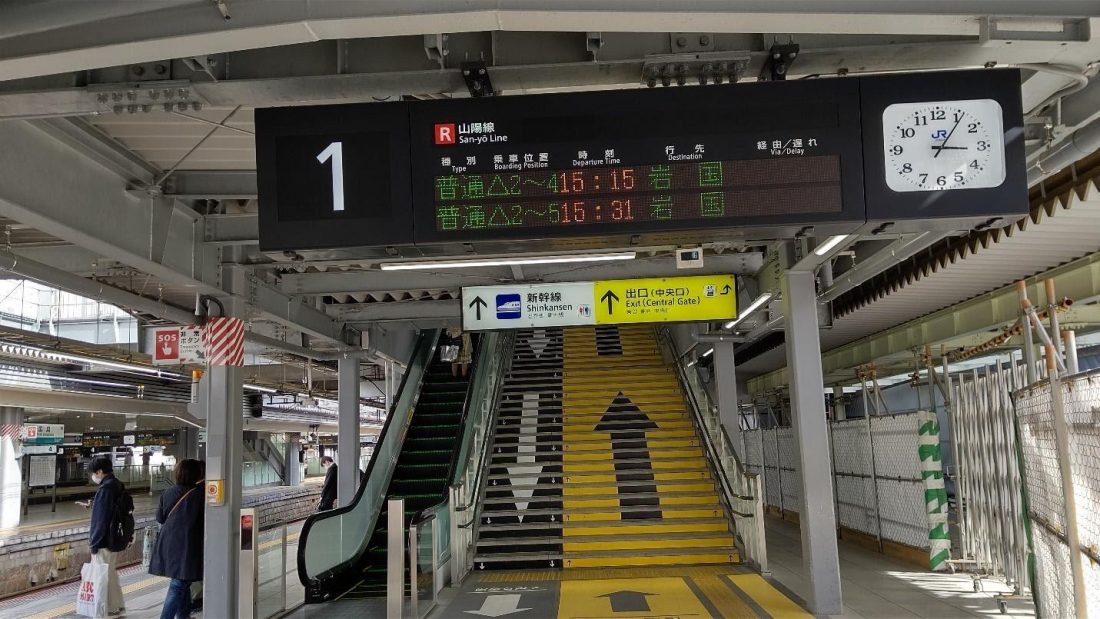
Platform #1, in Hiroshima Station, for the JR Sanyo Line bound for Iwakuni (stops at Miyajima Guchi)
Both JR and Astram function similarly so the following directions apply to both systems.
- Go through the ticket gates to get onto the platforms. *Note that there are always train staff around in case you have any questions but be aware that they may only know basic English.
- Past the ticket gates, refer to the signs that flash information between Japanese and English about the arrival time, destination name, platform number and other information about the coming trains. *Note that you may have to go over or under the tracks to get to another platform depending on which direction your train is going.
- Ride the train to your destination. *Note that trains are usually on time and come and go very quickly and if it is a “local” train it will stop at every stop but if it is an “express” train it will skip stops, make sure it won’t skip yours.
- At your destination, walk through the ticket gates to get out of the station by sticking the ticket in the slot or placing your IC card on the touch pad.
Paying with a Ticket vs. an IC Card: 
JR map above the ticket machines at Hiroshima Station. *Note the numbers by the destination names, those are the ticket prices when you’re coming from Hiroshima Station.
Tickets:
Buy a ticket at the machines outside the ticket gates. You have to match the destination name on the map above the machines with the ticket price on the screen. These machines accept both bills and coins and will give you change if you don’t have the exact amount. Instructions in English are available. Once you have your ticket, you can stick it in the slot of the ticket gate and walk through. *Note: DO NOT forget to take your ticket back as you walk through, you will need it again at your destination.
IC Card (*Note: JR doesn’t accept Paspy and Astram doesn’t accept ICOCA):
To pay with an IC card, place your card on the touch pad attached to the ticket gate and walk through (when your card is low on funds, the ticket gate will beep at you).
広電 “Hiroden” Hiroshima Electric Railway (Streetcar)
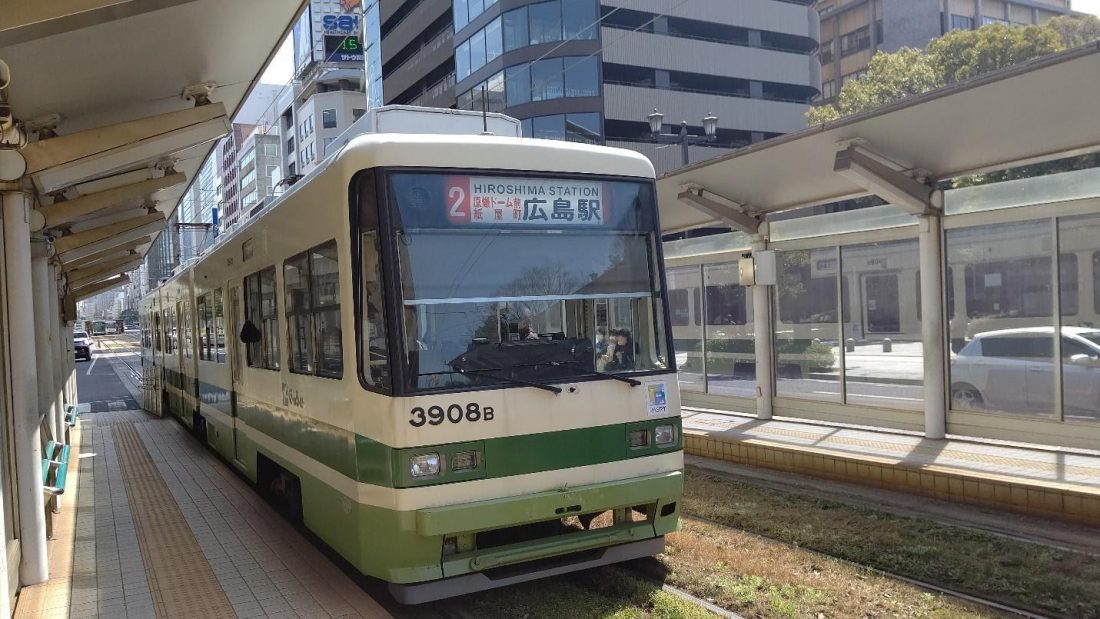
A Hiroden bound for Hiroshima Station, leaving from Genbaku domu mae
The official, English, name for Hiroshima’s streetcar system is the “Hiroshima Electric Railway” and the Japanese word for streetcar is 老麵電車 “roumen densha”, but locals refer to them as “Hiroden”.
Hiroden are a little slow, but they go all over the city, there is usually room for large bags, and they are one of the cheapest transportation options. I recommend using them to get around downtown (ex. the Peace Memorial Park and the Hondori shopping area). The Hiroden are also the most straightforward way to get to Hiroshima Port.
Navigating the Hiroden:
Most Hiroden “stations” are just small stops with a platform (usually unmanned). There will be a timetable and a list of the Hiroden routes that stop there.
- When the Hiroden arrives, step on, but avoid stepping in the doors with the driver or the ticketing staff.
- As you step on, there will be a touch pad for you to place your IC card. *Note: if you’re not paying with an IC card, you don’t have to do anything at this time.
- At your destination, leave the Hiroden through the driver’s door or the ticketing staff’s door.
- When you leave the Hiroden, place your IC card on the touchpad again. If you’re paying with coins, drop the coins into the slot provided. *Note: you will not get change back if you give too much.
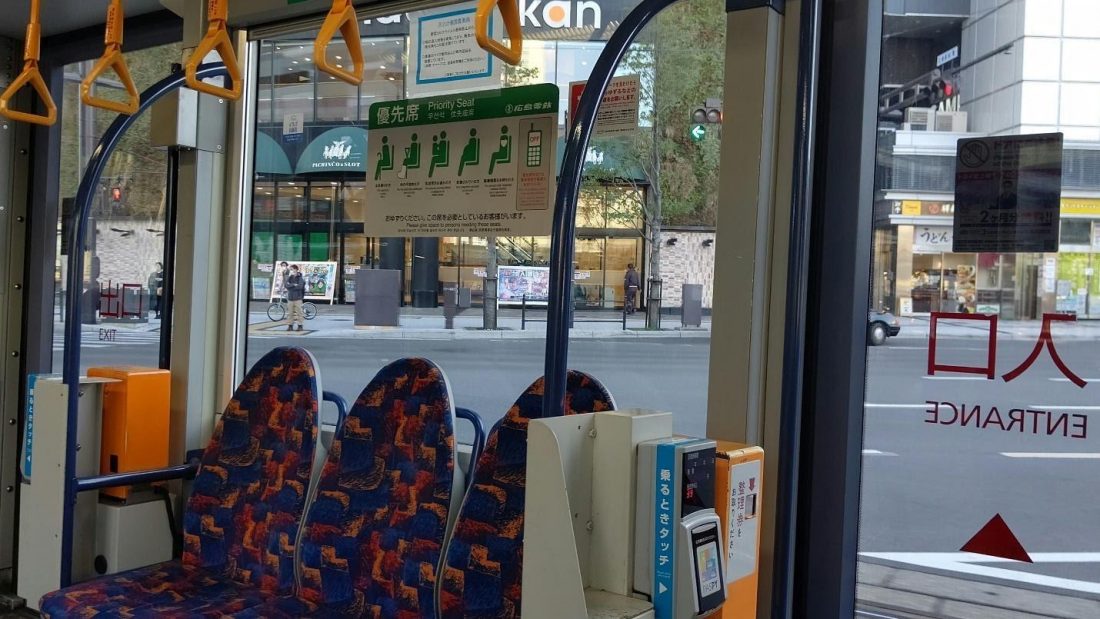
Inside the Number 2 Hiroden leaving from Hiroshima Station. *Note the IC card touch pad by the door.
Paying with Coins vs. an IC Card:
Coins:
If you pay with coins on the Hiroden, you always pay as you get off. There is no “ticket” for the Hiroden so you can just walk on. You can figure out how much you owe by referring to the price charts inside the Hiroden, you just need to know the name of the stations you are getting on and off at. If you’re confused, you can ask the ticketing staff. However, the flat fare for an adult within the city is ¥190. When you get off, you have to pay in exact change. If you don’t have exact change, there are change making machines on the Hiroden. *Note: try to get your change ready before your destination so you don’t hold up the Hiroden.
IC Cards (*Note: Hiroden accept both Paspy and ICOCA but you can’t charge ICOCA here)
If you pay with an IC card, place your card on the touchpad as you get on and as you get off the Hiroden. When your card is low on funds, the touch pad will announce, “chajishite kudasai!” (please charge!). There are charging machines on the Hiroden. *Note: the charging machines on the Hiroden only accept ¥1,000 bills.
バス “Basu” Bus
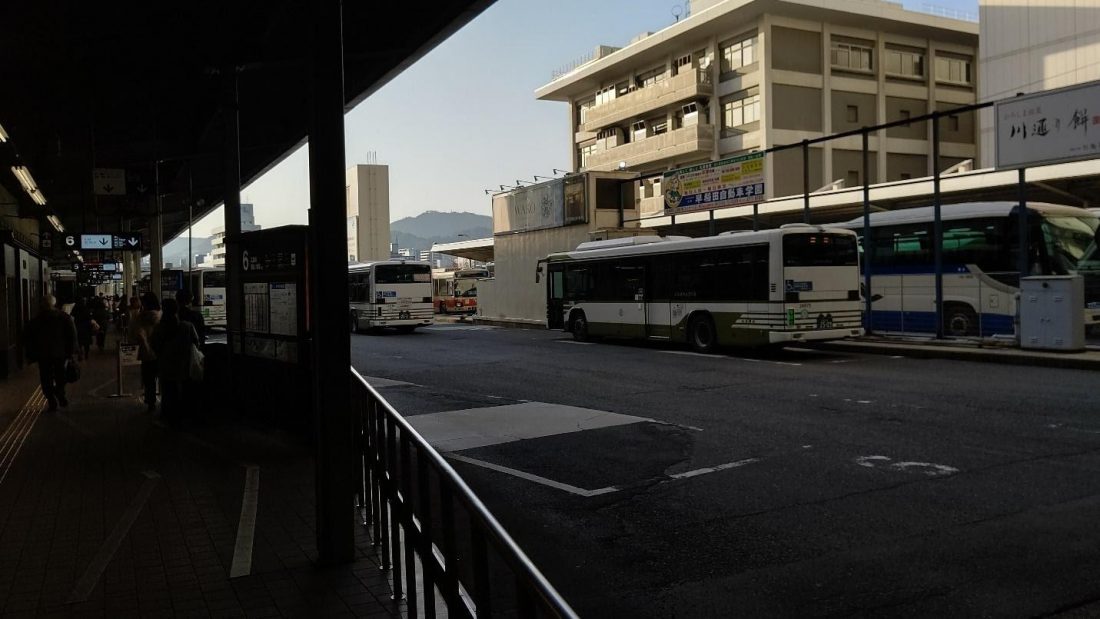
Buses lined up to leave Hiroshima Bus CenterHiroshima city has a lot of buses. They are arguably the most complex mode of transportation in the city, especially from a visitor’s perspective, and there isn’t a lot of extra room for luggage, but they go to the largest variety of places.
Most buses eventually stop at a major station, like Hiroshima Station, the Hiroshima Bus Center, or Yokogawa Station, and then proceed along their route, stopping at small, designated stops.
Buses are really handy for getting to the more remote places. I recommend using a bus to get to places like The Outlets Shopping Center, the Aquarium and the Botanical Gardens.
The Meipuru~pu routes are a separate system from the city bus routes but they are convenient if you are short on time and want a straightforward way to see all of the famous sights in the center of town (ex. the Peace Memorial Park, Hijiyama Park, Hiroshima Castle).
Navigating the Buses: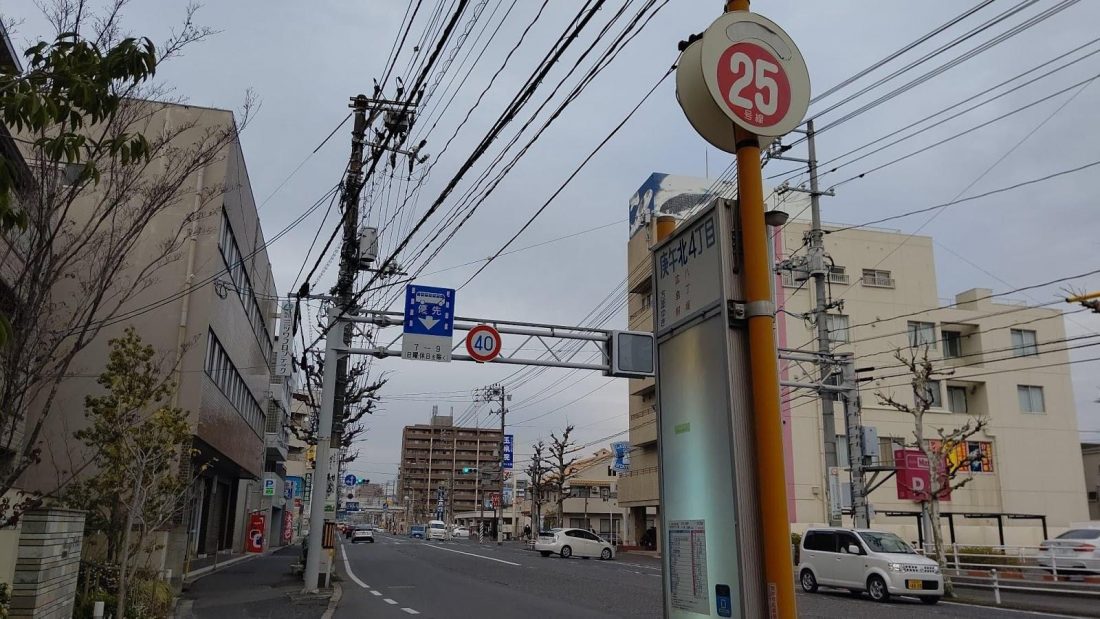
A bus stop in Nishi-Ku for the number 25 bus.
Bus terminals at major stations will have large signs indicating the destination name and platform number for the buses. However, out in the city, most bus stops are just a marker on the side of the road. These markers will have timetables and a list of the bus routes that stop there. *Note that there could be several bus stops close to each other but they belong to different bus routes, make sure you’re standing by the right one.
- When your bus arrives, make sure you’re standing close to the marker so the bus driver knows you wish to take the bus (buses don’t stop if no one appears to be at the marker).
- Avoid getting on the bus through the driver’s door, and take a ticket if you plan to pay with coins or place your IC card on the touchpad.
- There is a screen at the front of the bus that shows which stop is coming up next (in both English and Japanese), there will also be an announcement (but often not in English).
- When you know your destination is the next stop, press a button within reach that says 止まれ “tomare” stop. *Note the bus will not stop if no one presses the “stop” button.
- At your destination, get off at the driver’s door, place your IC card on the touchpad again or drop your coins in the slot. *Note you will not get change back if you give too much.
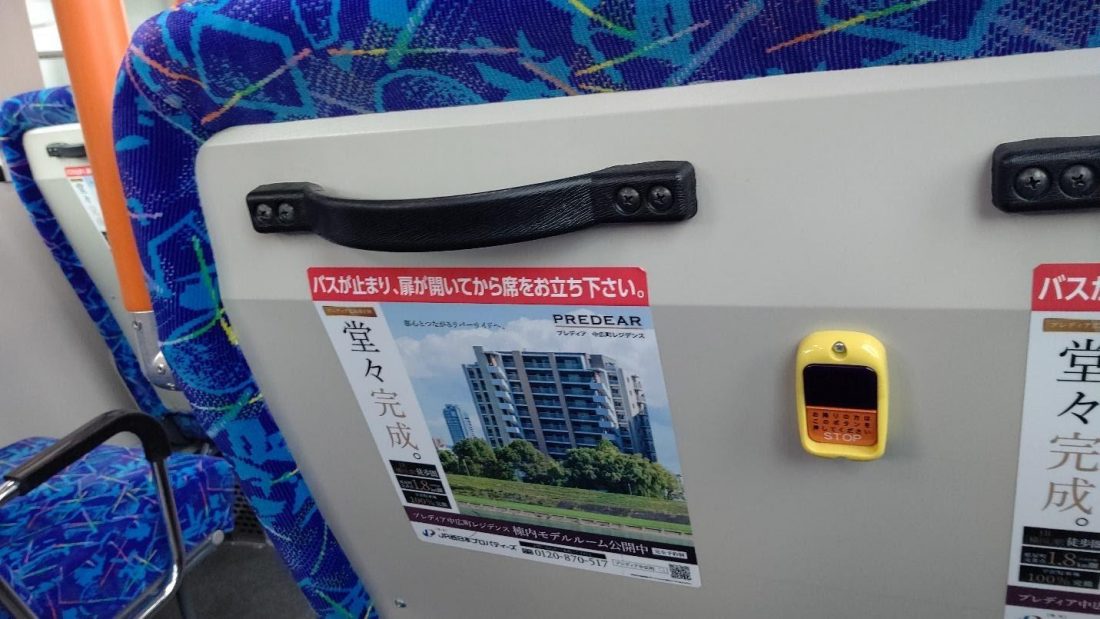
“stop” button on the back of a seat on a city bus.
Paying with coins vs. an IC Card
Coins:
If you pay with coins on the bus, you always pay as you get off. The “ticket” you take is so you can keep track of where you got on the bus. You can figure out how much you owe by matching your ticket with the prices on the screen in front of the bus. The price of a bus trip is always affordable but they vary so you have to pay attention. If you don’t have exact change, there are change making machines on the bus. *Note: try to get your change ready before your destination so you don’t hold up the bus.
IC Cards (*Note: buses accept both Paspy and ICOCA but you can’t charge ICOCA here):
If you pay with an IC card, place your card on the touchpad as you get on and as you get off the bus. When your card is low on funds, the touch pad will announce, “chajishite kudasai!” (please charge!). There are charging machines on the bus by the driver. *Note: the charging machines on the bus only accept ¥1,000 bills.
Suggestions and Other Important Points:
- Stay behind the yellow line on the platform until the train/streetcar comes to a complete stop (you will get yelled at by staff if you don’t)
- Step aside to let disembarking passengers off before you step on
- Speak quietly when you’re on the train/streetcar/bus
- No eating on any public transportation unless you are in a seat on a train specifically
- If you have large bags or luggage, keep it in front of you, especially during busy times (it’s easy for people to trip on or get smacked by big bags in tight corners)
- The worst of rush hour is weekdays between 7am-9am and between 5pm-7pm, I recommend avoiding these times if you have large bags (or if you don’t like crowds)
- Major station names always have English but some of the smaller stations don’t, if you need to go to smaller stations, knowing what the station name looks like in Japanese is a good idea
- Trains stop running between 11pm-12am and don’t start running again until between 5am-6am. Streetcars and buses stop running between 10pm-11pm and don’t start running again until between 5am-6am.
Other Modes of Transportation
You might come across a few other ways to get around as you explore the city. Let’s briefly go over them so you know what’s right for you.
Transportation on the Water:
Hiroshima boarders the 瀬戸内海 “seto naikai” the Seto Inland Sea, and the city itself has a lot of rivers. This makes for a fair amount of boat travel options.
River Boats: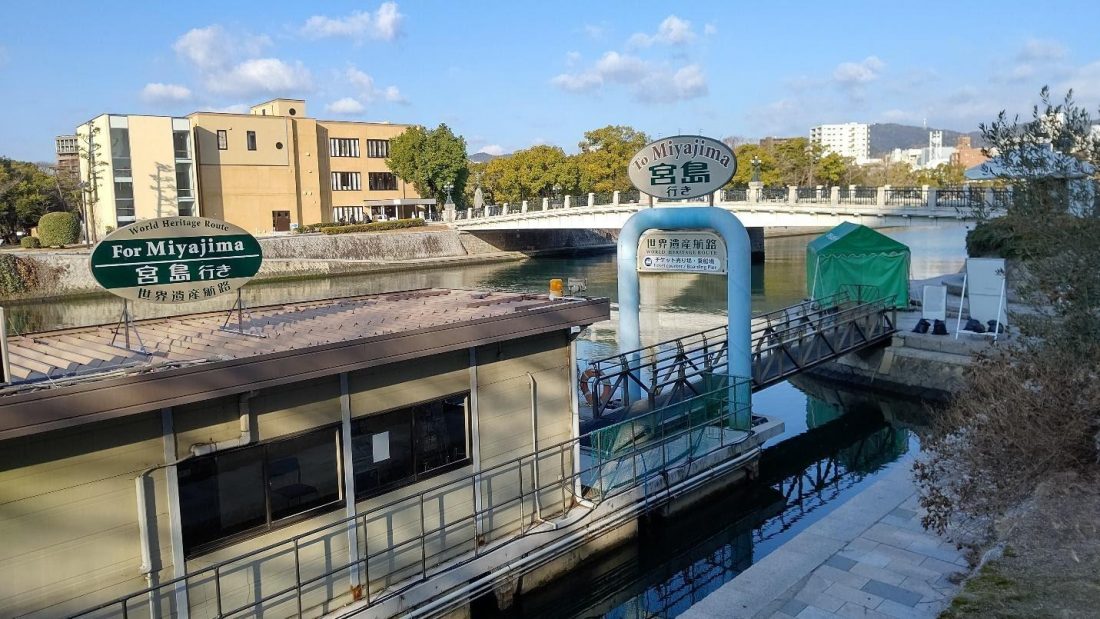
The little port on the Motoyasu River by the Peace Memorial Park. These boats go to Miyajima and Hiroshima Station.
There is a port for river boats on the Motoyasu River by the Peace Memorial Park and on the Enko River by Hiroshima Station. The boats that go between these two ports double as transportation and a sightseeing tour because English speaking guides talk about the city as you cruise up and down the rivers. The port on the Motoyasu River also has a boat that goes all the way to Miyajima and back. I recommend this if you are short on time and wanting to leave from and/or come back to the Peace Memorial Park area. It is the fastest and most straightforward way to get between the city’s two most famous landmarks (the A-Bomb Dome in the Peace Memorial Park and Itsukushima Shrine’s gate in Miyajima). You pay for your boat tickets beforehand, either at the port’s ticket counter or online.
Here is a link to check out more:
https://www.hiroshima-water-taxi.com/english/
Ferries: 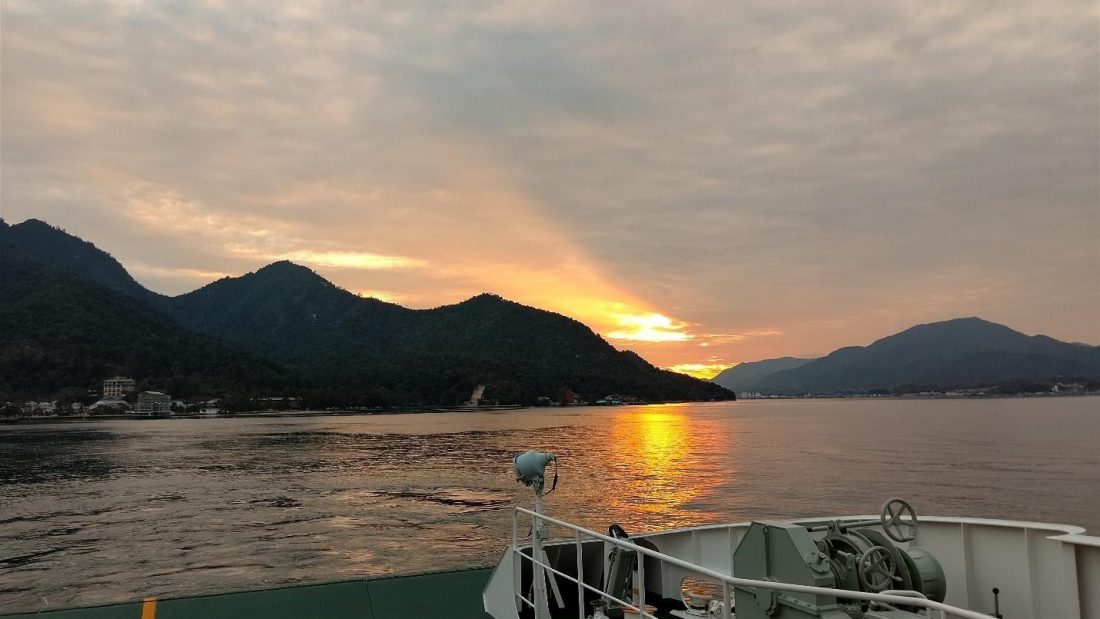
View from the Ferry leaving Miyajima Island for the Ferry Port in Hatsukaichi. The mountains in the foreground are part of Miyajima island.
Hiroshima Port is the city’s largest port and it has a wide variety of boats that go to Miyajima, all over the Seto Inland Sea and beyond. If you are interested in exploring more of this part of Japan, Hiroshima Port is a good place to go.
There is a smaller port by Hiroshima’s Aquarium called Marina Hop Mariho. It is possible to get boats from here to Miyajima as well.
The most common way for both locals and tourists to get to Miyajima is to take the JR or the Hiroden to Miyajima Guchi in Hatsukaichi city and then taking the ferry to the island. The ferry port is only a 5-to-10-minute walk from both the JR and Hiroden stations.
How you get to Miyajima depends on where you are in the city and how you want to get there. Leaving from Hiroshima Port or Marina Hop is going to be more expensive but the boats from these places usually include a meal and entertainment/a tour of the Seto Inland Sea during your journey. Leaving from the port in Hatsukaichi is much cheaper and you can use an IC card but there is no food or entertainment, it’s just a ride.
Rental Bicycles: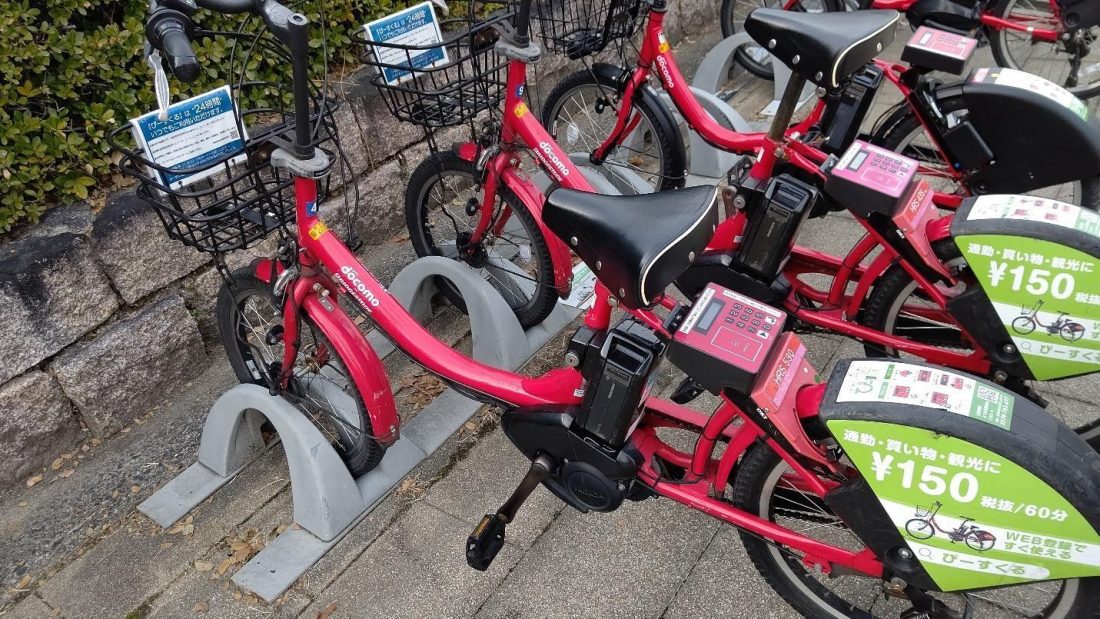
A Rental Bicycle port by Hiroshima Castle.
If you like exploring places via a bicycle, this might be a good choice for you. There are rental bicycle ports all over downtown and a few off the beaten path. They are easy to spot because they are bright red, and they are electric, making them very easy to peddle. The idea is “bicycle sharing”, so you take a bike, use it, and return it to a port when you’re done.
The local Rental Bicycle company is called ぴーすくる “Pi-sukuru” and they have “ticket counters” all over the city where you can get more information.
If you are only going to be in town for a couple days and you’re interested in this, I recommend going to one of the ticket counters and signing up for day passes in person. If you’re going to be here a while, you should become a member because it’s cheaper in the long run. However, it can be kind of a pain to set up, but once you are it’s really easy. You become a member online with your phone number, email, and credit/debit card info and they send you a passcode. With that passcode, you can enter it on the bike’s keypad every time you want to rent a bike, or you can use it to register your IC card and then use that every time you rent a bike.
Here is a link to the Pi-sukuru’s website:
https://docomo-cycle.jp/hiroshima/en/





